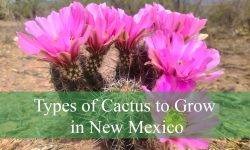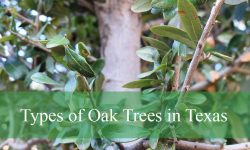There are several types of trees with red flowers that add vibrant hues to landscapes. These trees are known for their stunning red blooms, each contributing to the visual appeal of gardens and outdoor spaces. This article will help you discover about 29 different types of trees with red flowers.
Different Types of Trees with Red Flowers
1. Red Flowering Camellia (Camellia japonica)
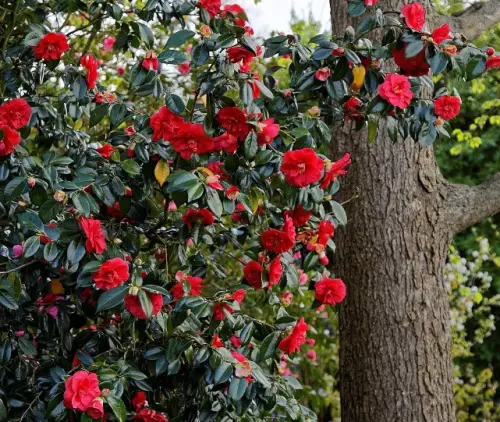
The Red Flowering Camellia (Camellia japonica) presents vivid red blooms similar to peonies or roses, coupled with glossy evergreen foliage. Flourishing in various light conditions, this adaptable tree includes types such as ‘Kramer’s Supreme’ displaying abundant peony-like flowers, ‘Australis’ showcasing wavy, ruffled rose-red petals, ‘Bob Hope’ featuring deep red semi-double blooms, and ‘Lady Campbell’ highlighting bright red rose-shaped flowers. It reaches a mature size of 6-12 ft. tall and 6-10 ft. wide, suitable for USDA Zones 7-9, thriving in partial to deep shade.
2. Flame Tree (Brachychiton acerifolius)
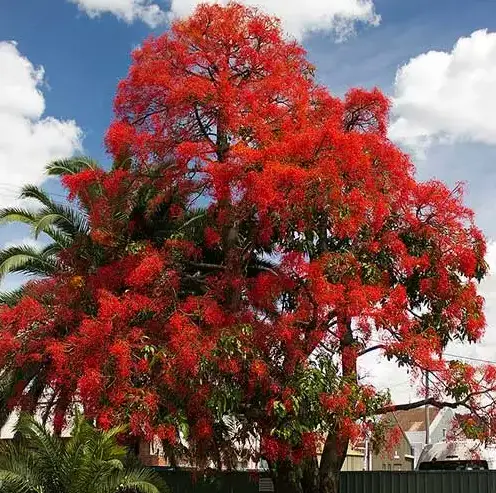
The Flame Tree (Brachychiton acerifolius) showcases clusters of vibrant red or scarlet bell-shaped flowers, attracting birds with its fragrant nectar. Its wide canopy and maple-like leaves provide a lush green backdrop, turning yellow in autumn. This ornamental tree, reaching 30-50 ft. tall and 25-40 ft. wide, thrives in USDA Zones 9-11, basking in full sun to partial shade.
3. Firewheel Tree (Stenocarpus sinuatus)
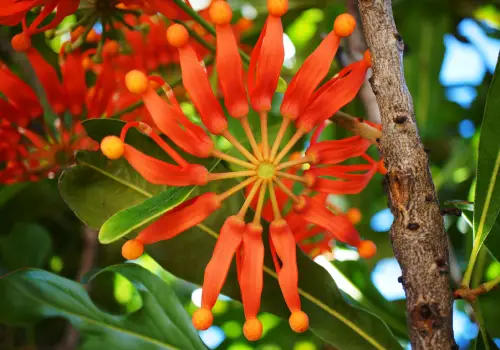
Native to Australia, the Firewheel Tree (Stenocarpus sinuatus) captivates with fiery wheel-like red bell-shaped flowers. Its glossy, fern-like green leaves provide a striking contrast. Low maintenance and adaptable to various soils, it thrives in full sun to partial shade, growing 30-50 ft. tall and 20-25 ft. wide. Ideal for tropical landscapes, it adds vibrant red hues to mixed plantings.
4. Red Maple (Acer rubrum)
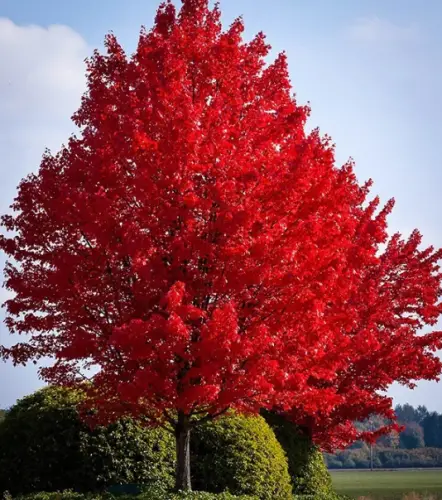
The Red Maple (Acer rubrum) dazzles with red flowers, green summer foliage, and striking yellow and red fall leaves. Its reddish-pink seed capsules and aging furrowed bark add to its appeal. Ideal for various uses like shade trees or focal points, it thrives in USDA Zones 3-9, basking in full sun to partial shade. Size: 40-70 ft. tall, 30-50 ft. wide.
5. Common Flowering Quince (Chaenomeles speciosa)
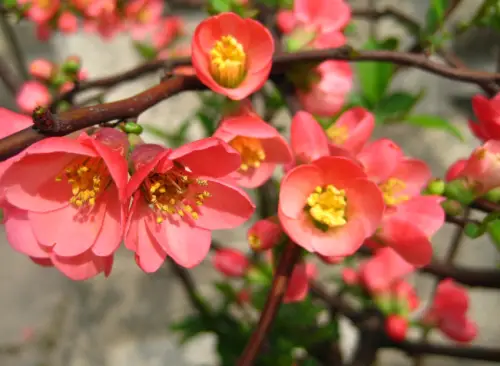
The Common Flowering Quince (Chaenomeles speciosa) is a thorny shrub or small tree boasting scarlet-red, cup-shaped flowers in late winter and early spring, luring bees and butterflies. Its glossy dark green leaves turn red or burgundy in autumn, enhancing its appeal. This adaptable plant suits various soils, functioning as a hedge, privacy screen, or standalone specimen in USDA Zones 4-9. Mature size: 6-10 ft. tall and wide. Thrives in full sun to partial shade.
6. Waratah (Telopea)

The striking Waratah (Telopea) tree showcases bold red or pink rounded flowers resembling traditional waratah blooms. With dark green, leathery leaves and a dense, compact growth, it serves as an ideal garden focal point or standalone specimen. Thriving in well-drained soil and full sun to partial shade, it withstands drought once established. Mature size: 3-10 ft. tall and wide. USDA Zones: 8-10.
7. Red Flowering Grevillea Trees
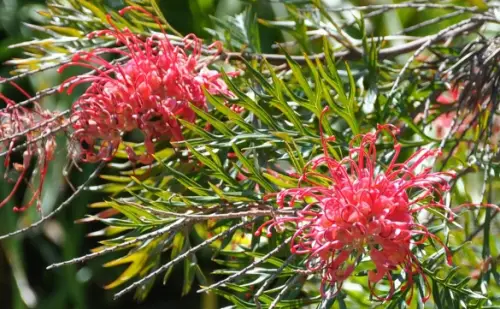
Renowned for their year-round stunning red blooms, the Red Flowering Grevillea Trees draw birds and bees. Their spidery red flowers boast curled petals and arching stamens, exuding an exotic feel. Adaptable to xeriscapes and coastal landscapes, these drought-tolerant trees function as hedges, screens, or specimen plants. Sizes vary from 4 to 8 ft. tall. They thrive in USDA Zones 9-11, preferring full to partial shade.
8. Red Angel’s Trumpet Tree (Brugmansia sanguinea)
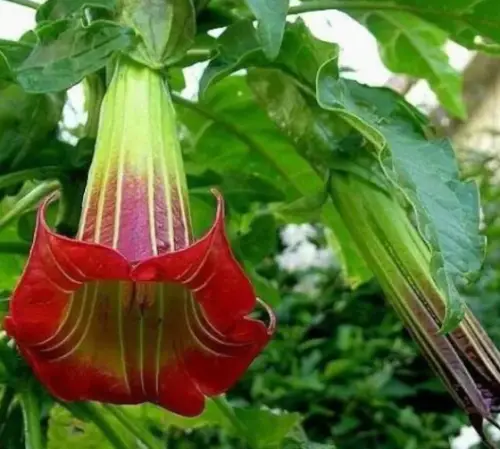
The Red Angel’s Trumpet Tree (Brugmansia sanguinea) mesmerizes with large, pendulous, multi-colored funnel-shaped flowers. Its tropical allure and fragrant blooms attract hummingbirds and butterflies. Ideal for warmer regions, it thrives in gardens, as borders, or in containers for patios. Caution is advised as all parts are toxic if ingested. Mature size: 8-12 ft. tall, 6-8 ft. wide. USDA Zones: 9-11. Sun: Full to partial shade.
9. Flame of the Forest Tree (Butea monosperma)
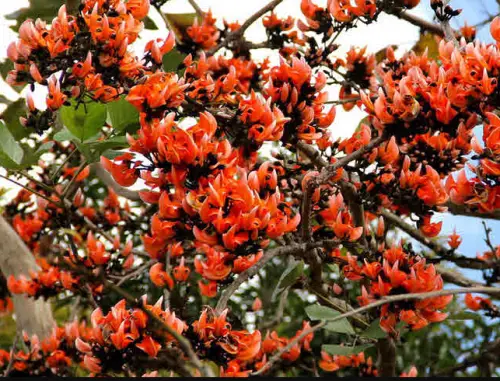
The Flame of the Forest Tree (Butea monosperma) dazzles with its brilliant orange-red floral display in late winter and early spring. Its wide, spreading canopy and bronze-brown pods add to its allure. Ideal as shade trees, they thrive in various soils, preferring rich, well-drained ones. Size: 30-40 ft. tall and wide. USDA Zones: 10-12. Sun: Full to partial shade.
10. ‘Hardy Red’ Oleander (Nerium oleander ‘Hardy Red’)

The ‘Hardy Red’ Oleander (Nerium oleander ‘Hardy Red’) charms with its deep red, funnel-shaped summer blooms, known for enduring colder temperatures. Its vase-shaped canopy and dark green lanceolate leaves make it an ideal hedge, privacy screen, or specimen plant. Drought-tolerant and low-maintenance, it thrives in hot, dry regions. Caution advised as all parts are toxic if ingested. Size: 6-15 ft. tall, up to 10 ft. wide. USDA Zones: 7-12. Sun: Full sun.
11. Indian Coral Tree (Erythrina variegata)
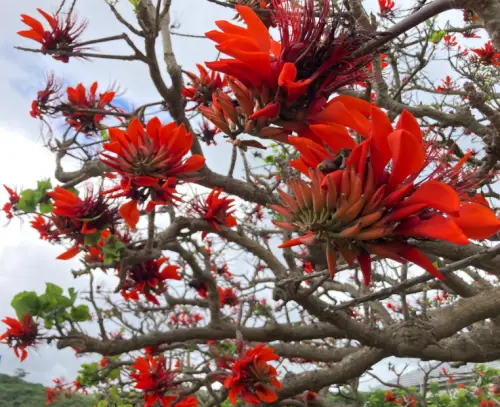
The Indian Coral Tree (Erythrina variegata) captivates with its crimson or scarlet coral-like flowers, attracting birds and butterflies. With large compound leaves, it thrives in warm climates, adorning large gardens and parks with its vibrant flowers and spreading canopy. Ideal for tropical and subtropical regions, it prefers well-drained soil and full sun. Size: 20-40 ft. tall and wide. USDA Zones: 10-11.
12. Red Silky Oak Tree (Alloxylon flammeum)
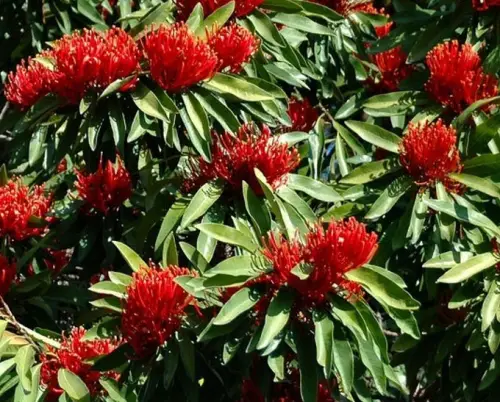
The Red Silky Oak Tree (Alloxylon flammeum) captivates with its vibrant red tubular flowers in clusters, contrasting its lance-shaped leaves. Ideal as a specimen tree, it thrives in large gardens and open landscapes, providing a broad, dense canopy for shade. Size: 30-50 ft. tall, 20-30 ft. wide. USDA Zones: 9-11. Sun: Full to partial shade.
13. Pomegranate Tree (Punica granatum)
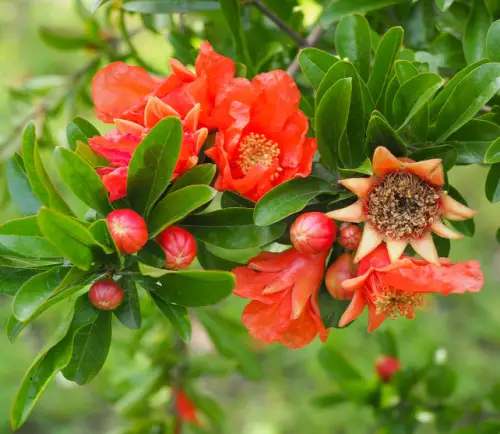
The Pomegranate Tree (Punica granatum) delights with vibrant cup-shaped scarlet flowers and flavorful aril-filled fruits. Identified by its multi-stemmed habit and oblong leaves, it adds seasonal interest with yellow foliage in the fall. Ideal for Mediterranean-style gardens or patio containers, it reaches 6-20 ft. tall and 4-5 ft. wide. USDA Zones: 8-11. Sun: Full sun.
14. Red Flowering Gum Tree (Corymbia ficifolia)
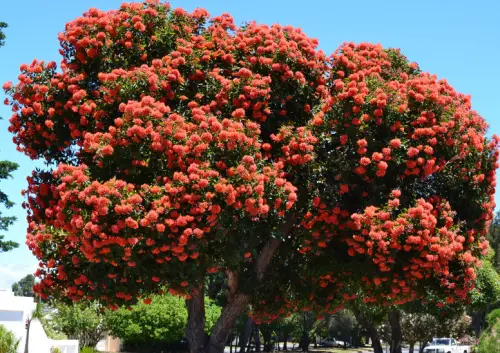
The Red Flowering Gum Tree (Corymbia ficifolia) dazzles with its vibrant clusters of large, showy flowers in shades of red, pink, or orange. Its glossy, dark green leaves and urn-shaped fruits add to its allure. Drought-tolerant, it thrives in hot, dry landscapes as a specimen or shade tree. Size: 20-40 ft. tall, 15-60 ft. wide. USDA Zones: 9-11. Sun: Full to partial shade.
15. Red Bird of Paradise (Caesalpinia pulcherrima)
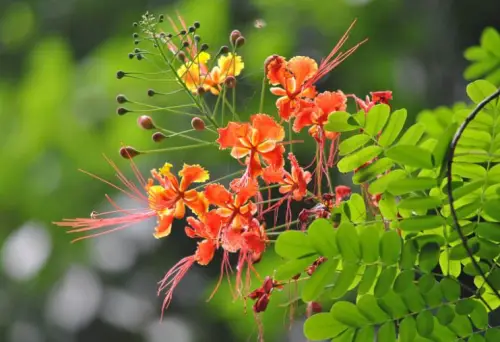
The Red Bird of Paradise (Caesalpinia pulcherrima), or peacock flower, features striking red and orange bowl-shaped blooms on prickly stems, akin to the royal Poinciana tree. With fern-like leaves and spiny branches, it thrives in hot, dry climates, perfect for desert gardens or xeriscapes. Ideal as a specimen or border tree, it brings tropical allure to compact spaces. Size: 10-20 ft. tall, 6-12 ft. wide. USDA Zones: 9-11. Sun: Full sun.
16. Powderpuff Tree (Calliandra haematocephala)
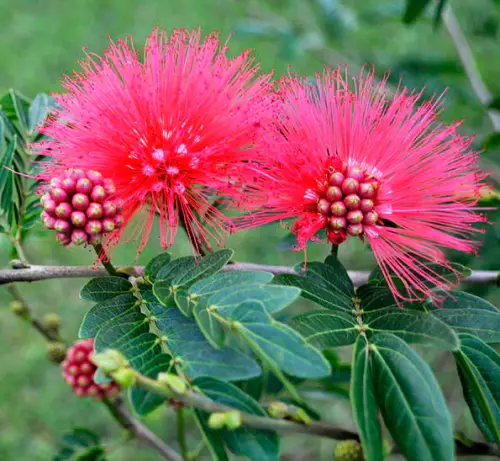
The Powderpuff Tree (Calliandra haematocephala) boasts distinctive scarlet red flowerheads contrasting with delicate fern-like leaves. Flourishing in tropical landscapes, its vibrant red blooms appear in fall and winter. Thriving in well-drained, fertile soil, it tolerates heat and drought, requiring minimal pruning. This compact tree reaches 3-6 ft. in height and width, suitable for USDA Zones 9-11, basking in full sun.
17. African Tuliptree (Spathodea campanulata)
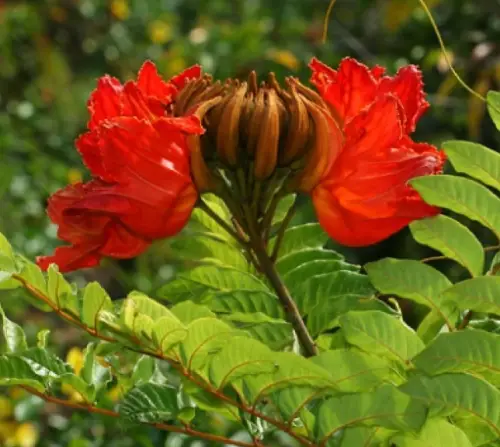
The African Tuliptree (Spathodea campanulata) impresses with its large reddish-orange cup-shaped flowers attracting hummingbirds and butterflies. With glossy green leaves and a distinctive trunk, it thrives in warm, humid climates. Common in city parks, it reaches 25-40 ft. tall and 15-20 ft. wide. Suitable for USDA Zones 10-11. Sun: Full sun.
18. Red Silk Cotton Tree (Bombax ceiba)
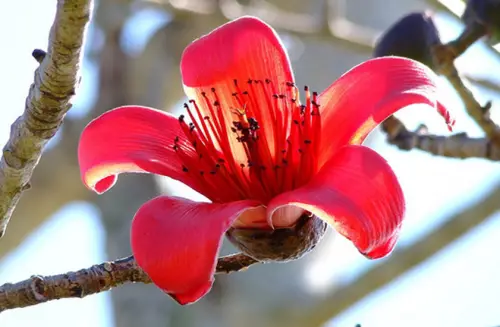
The Red Silk Cotton Tree (Bombax ceiba) flourishes in tropical regions, showcasing smooth gray bark, vibrant red flowers, and palmate green leaves. It prefers warm climates and serves as a shade tree in open spaces and parks. A common sight in Florida and other southern states, it grows 60-70 ft. tall and 40-60 ft. wide. USDA Zones: 10-12. Sun: Full sun.
19. Crabapple (Malus prairifire)
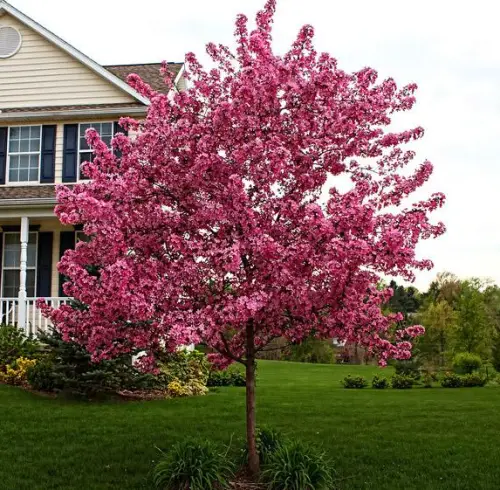
The ‘Prairifire’ Crabapple (Malus prairifire) boasts dark pink to red flowers in dense clusters, enhancing its upright rounded canopy in mid to late spring. Its vibrant red shades and small cherry-like apples add allure. With recognizable purplish-red veined leaves and golden-bronze fall foliage, it thrives in moderately fertile, well-drained soil. Size: 15-20 ft. tall and wide. USDA Zones: 4-8. Sun: Full sun.
20. Red Flowering Dogwood Tree (Cornus florida ‘Cherokee Chief’)
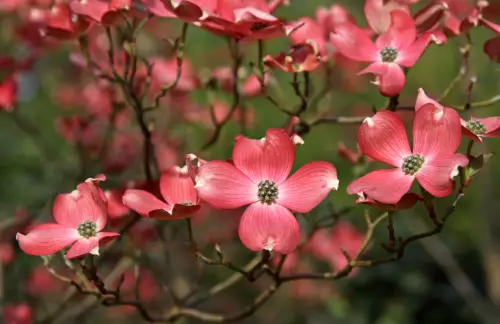
The Red Flowering Dogwood Tree (Cornus florida ‘Cherokee Chief’) graces small gardens with its vibrant red flowers in spring. Its ovate green leaves turn scarlet and purple in fall, complementing its alligator-skin-like bark. Ideal for shade or borders, it thrives in acidic to neutral, well-drained, moist soil. Size: 20-25 ft. tall, 12-18 ft. wide. USDA Zones: 5-9. Sun: Full to partial shade.
21. Royal Poinciana Tree (Delonix regia)
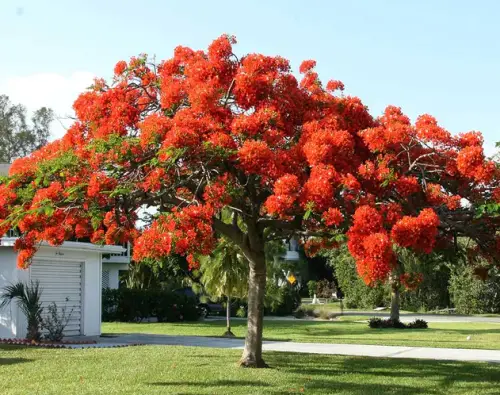
The Royal Poinciana Tree (Delonix regia), also known as the flamboyant tree, dazzles with its scarlet-orange umbrella-like canopy of 4” (10 cm) wide flowers. Its fern-like foliage and ornamental seed pods add to its charm, offering year-round interest. Ideal for landscaping, it thrives in well-drained soil, reaching 30-40 ft. tall and 40-70 ft. wide. USDA Zones: 10-12. Sun: Full sun.
22. Chinese Hibiscus Tree With Red Flowers (Hibiscus rosa-sinensis)
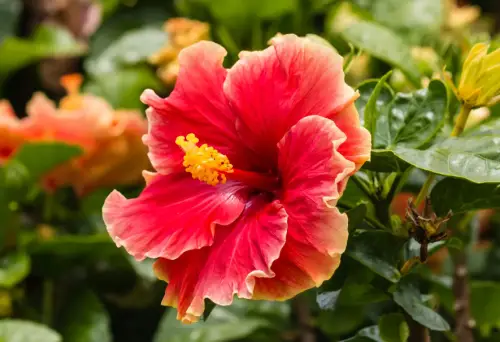
The Chinese Hibiscus (Hibiscus rosa-sinensis) delights with its large, fragrant, trumpet-like red flowers measuring up to 4” (10 cm). With glossy lance-shaped leaves, it thrives in well-drained soil in full sun to partial shade. This tropical evergreen reaches 8-16 ft. tall and 5-10 ft. wide. Ideal for ornamental uses, it flourishes in USDA Zones 10-12.
23. Red Frangipani Tree (Plumeria Rubra)
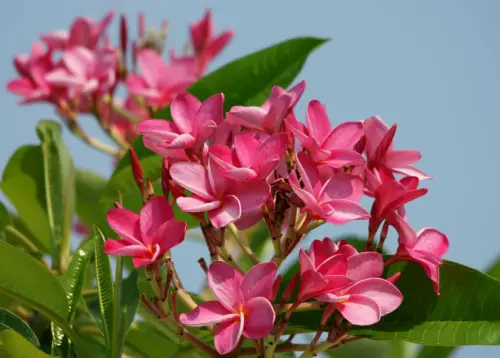
The Red Frangipani Tree (Plumeria Rubra) enchants with its year-round, sweet-scented, magenta-red star-shaped flowers. Its lush foliage and small to medium size make it ideal for tropical gardens and containers. Thriving in hot, humid climates, it prefers well-drained soil and full sun. Reaching 15-25 ft., it flourishes in USDA Zones 10-12.
24. Tree Rhododendron (Rhododendron arboreum)
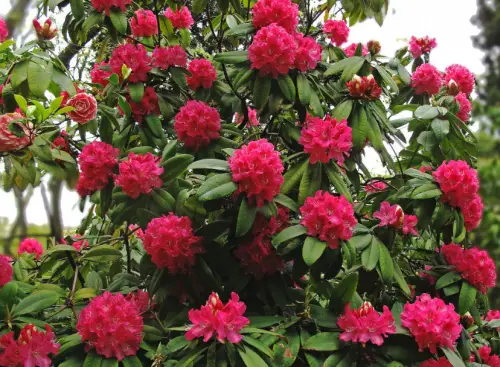
The Tree Rhododendron (Rhododendron arboreum) impresses with its large, bright red, trumpet-shaped flowers emitting a sweet fragrance. This evergreen shrub can be trained into a small tree, suitable for larger landscapes. It prefers acidic, well-drained soil and partial shade. Cold-hardy in USDA Zones 7-9, reaching 20-40 ft.
25. Crimson Bottlebrush Tree (Melaleuca citrina)
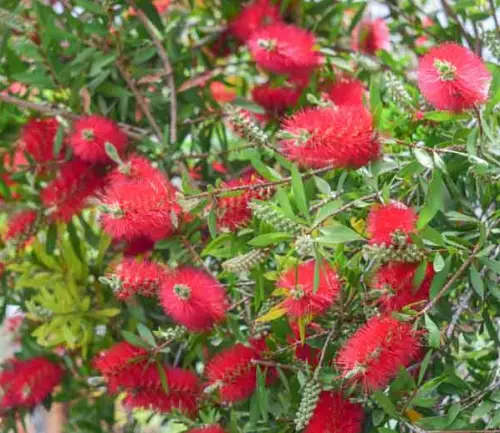
The Crimson Bottlebrush Tree (Melaleuca citrina) features distinctive, bright red, bottlebrush-shaped flowers and fragrant citrusy leaves. This sun-loving, drought-tolerant tree thrives in well-drained soil. With a mature size of 8-15 ft., it’s ideal for hedges, foundation plantings, or ornamental shrubs in coastal gardens. USDA Zones: 8-11. Sun: Full sun.
26. Red Flowering Magnolia Trees
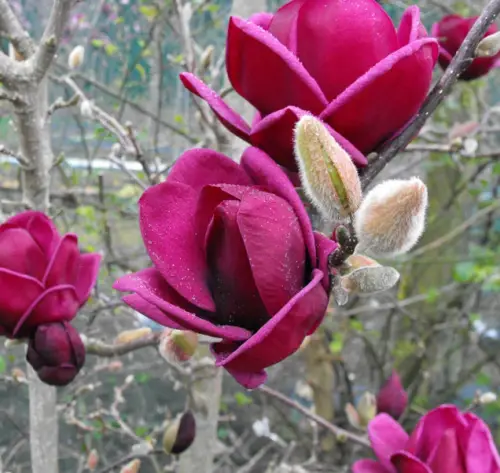
Red Flowering Magnolia Trees showcase stunning cup-shaped flowers in rich ruby-red shades. The magnolia trees feature attractive mid-green leaves and are generally low maintenance. Notable varieties include ‘Vulcan’ with deep pink to red blooms and ‘Red As’ with goblet-shaped dark purple-red flowers. Mature size: 10-15 ft. tall, 8-10 ft. wide. USDA Zones: 5-9. Sun: Full sun to light shade.
27. Red Buckeye (Aesculus pavia)
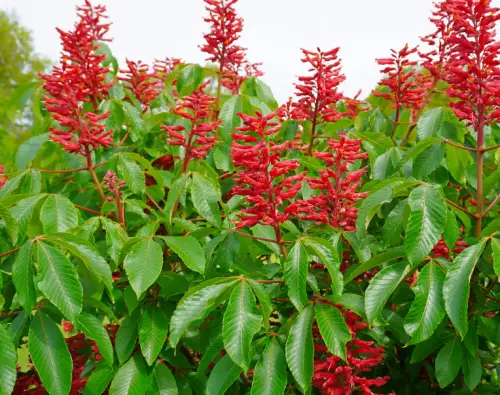
Red Buckeye trees feature vibrant tubular red flowers that attract hummingbirds and butterflies. The small trees have palmate leaves and produce dark brown toxic seeds. They thrive in woodland or native gardens, preferring moist, well-drained soil. Mature size: 12-15 ft. tall and wide. USDA Zones: 5-9. Sun: Partial shade to full sun.
28. Red Horse Chestnut (Aesculus carnea)
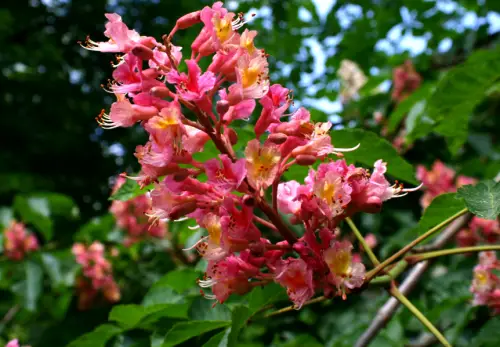
The Red Horse Chestnut tree showcases cone-shaped clusters of bright red flowers, creating a stunning spring display. With large palmate leaves and a fast-growing, rounded shape, it serves well for shade or as a focal point. Thriving in well-drained soil, it requires minimal maintenance and can tolerate drought conditions once established. Size: 30-40 ft. tall and wide. USDA Zones: 5-8. Sun: Full to partial shade.
29. Crape Myrtle (Lagerstroemia)
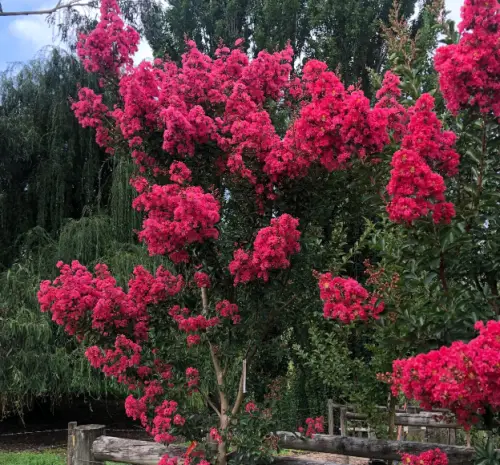
The fast-growing Crape Myrtle is a vibrant flowering tree available in various colors, including striking shades of red. Its crinkled flowers bloom all summer, making a bold statement. With adaptable landscaping uses, it thrives in a wide range of soils and withstands heat and drought. Mature sizes vary from 8 to 30 ft. tall, depending on the variety. USDA Zones: 6-9. Sun: Full to partial shade.
People Who Read This Also Read:


